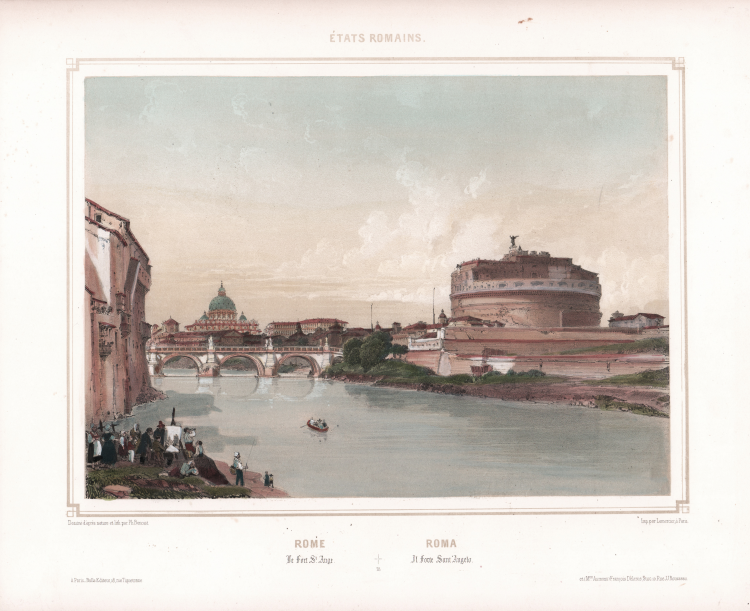



| Reference: | S46303 |
| Author | Philippe BENOIST |
| Year: | 1860 ca. |
| Zone: | Castel Sant'Angelo |
| Printed: | Paris |
| Measures: | 365 x 290 mm |


| Reference: | S46303 |
| Author | Philippe BENOIST |
| Year: | 1860 ca. |
| Zone: | Castel Sant'Angelo |
| Printed: | Paris |
| Measures: | 365 x 290 mm |
A beautiful view, drawing and lithograph by Philippe Benoist. Signed lower left "Dessiné dèpres nature et lith par Ph. Benoist", on the right "Imp. par Lemercier, à Paris". Caption in French and Italian.
Tinted lithograph, in good condition. Taken from L'Italie monumentale & artistique. Vues et monuments dessinés d'après nature par Ph. Benoist et lithographiés aux deux crayons par Bachelier, Ph. Benoist & Jacottet, published in Paris around 1860.
Philippe Benoist (Geneva, 1813-1905) was a pupil of the great master Louis Jacques Mandé Daguerre (Cormeilles-en-Paris, 1787- Bry-sur-Marne, 1851) a painter of figures, architecture, interiors, landscapes, theatre decorator, watercolourist, designer and above all inventor of the daguerreotype which takes its name from him, he was awarded the Légion d’honneur. Philippe learned from his master the art of executing landscapes in oil and watercolour, but his fame is linked above all to lithography. As an original lithographic artist, Philippe Benoist specialized in exterior and interior views of many famous buildings. They were usually published in series, and among the most famous are the Monuments du Moyen Age, L'Italie Monumentale et Artistique and the Vues de Paris. In 1855 he illustrated an album of sculptures in the choir of Notre-Dame de Paris. He painted and engraved in stone the interiors and exteriors of churches: Saint-Paul in Lyon, the cathedrals of Toledo, Reims, and Saint-Eustace in Paris. His paintings were exhibited almost every year at the Paris Salon between 1836 and 1879. His works are usually signed P. Benoist, Ph Beonist or simply Benoist.
Philippe BENOIST (Ginevra 1813 – Parigi 1905)
|
One of France's most gifted topographical artists of the 19th century, Philippe Benoist was both a master lithographer and painter. He began his career in Paris studying and apprenticing under the most influential pioneer of early photography, Louis Daguerre. By 1836, however, Philippe Benoist had turned entirely to art and was exhibiting his views at the Paris Salons and continued to do so until1879. As an original lithographic artist, Philippe Benoist specialized in exterior and interior views of many famous buildings. These were usually published in sets, such as Monuments du Moyen Age, L'Italie Monumentale et Artistique and Vues de Paris, published in 1881. It represents one of the artist's finest undertakings as each lithograph was printed in subtle colors using a number of tint stones. Finally, the figures and some of the foreground objects were then hand-colored by commissioned artists. The end result produced by these large and elaborate lithographs, thus more than justifies Philippe Benoist's position as one of the greatest artists of interior views and monumental scenes of his time.
|
Philippe BENOIST (Ginevra 1813 – Parigi 1905)
|
One of France's most gifted topographical artists of the 19th century, Philippe Benoist was both a master lithographer and painter. He began his career in Paris studying and apprenticing under the most influential pioneer of early photography, Louis Daguerre. By 1836, however, Philippe Benoist had turned entirely to art and was exhibiting his views at the Paris Salons and continued to do so until1879. As an original lithographic artist, Philippe Benoist specialized in exterior and interior views of many famous buildings. These were usually published in sets, such as Monuments du Moyen Age, L'Italie Monumentale et Artistique and Vues de Paris, published in 1881. It represents one of the artist's finest undertakings as each lithograph was printed in subtle colors using a number of tint stones. Finally, the figures and some of the foreground objects were then hand-colored by commissioned artists. The end result produced by these large and elaborate lithographs, thus more than justifies Philippe Benoist's position as one of the greatest artists of interior views and monumental scenes of his time.
|